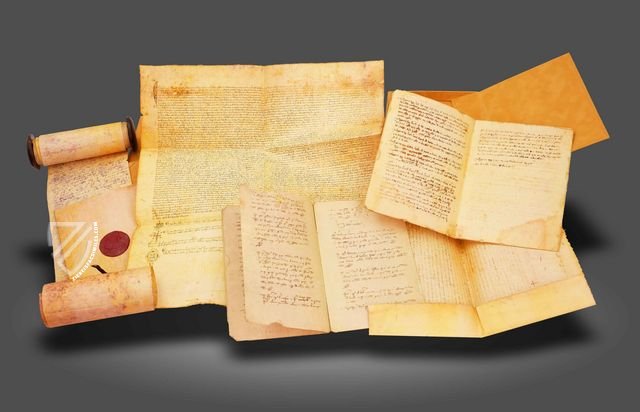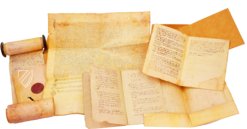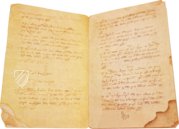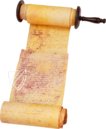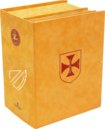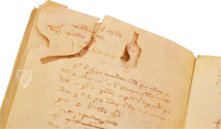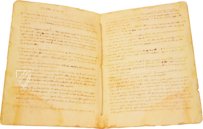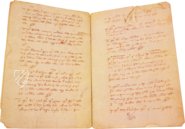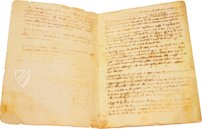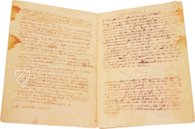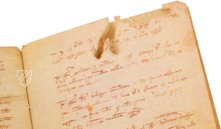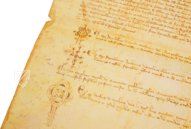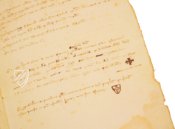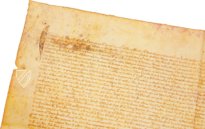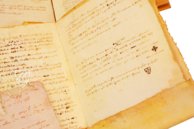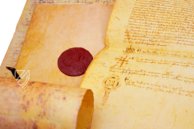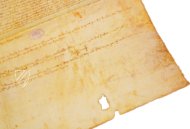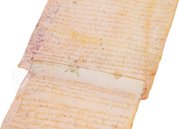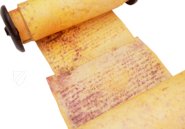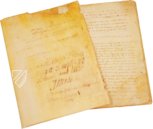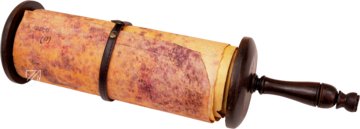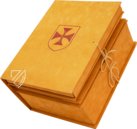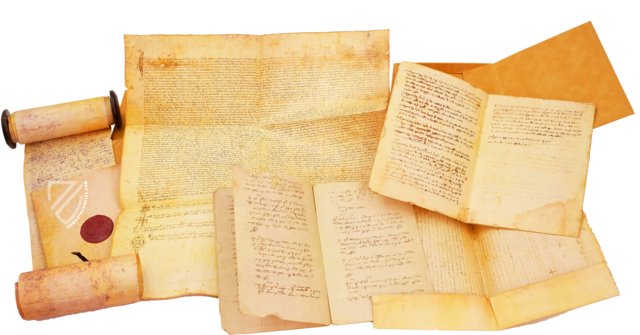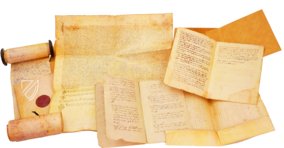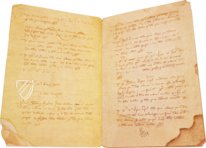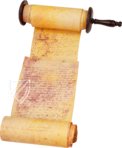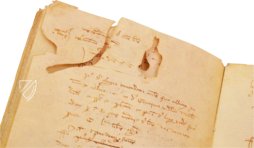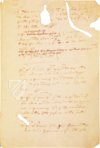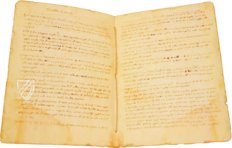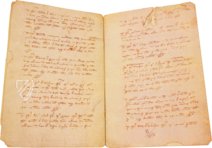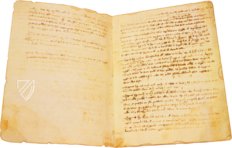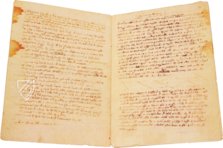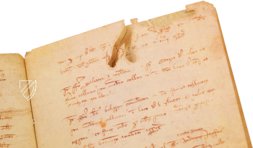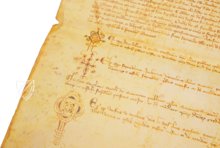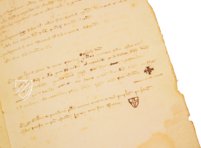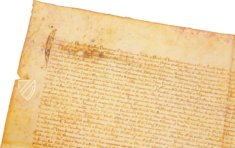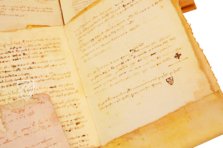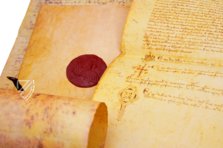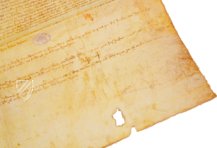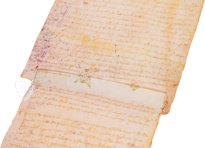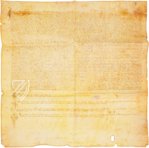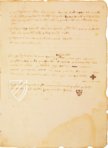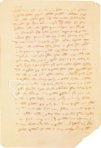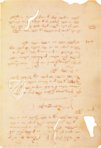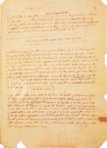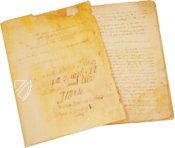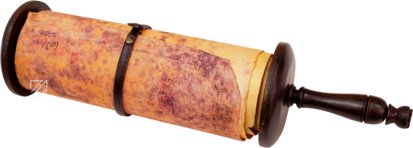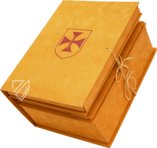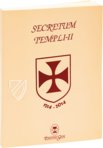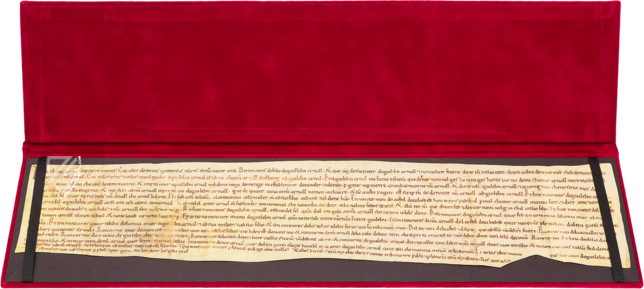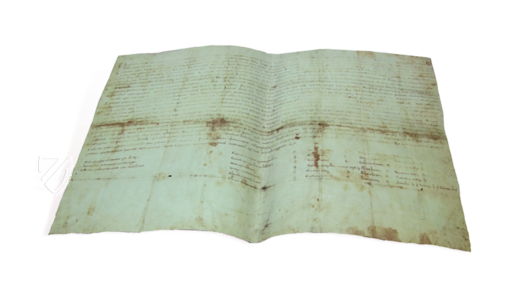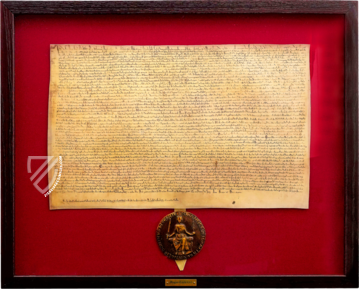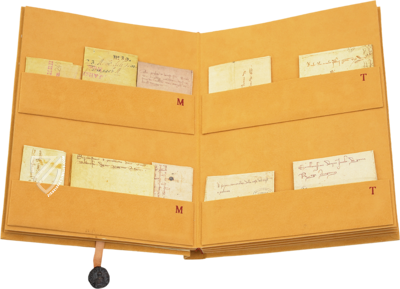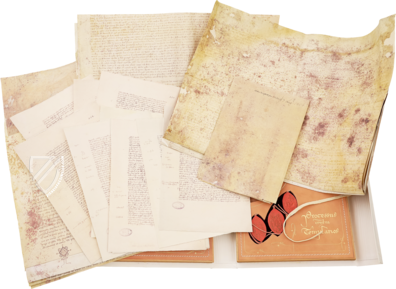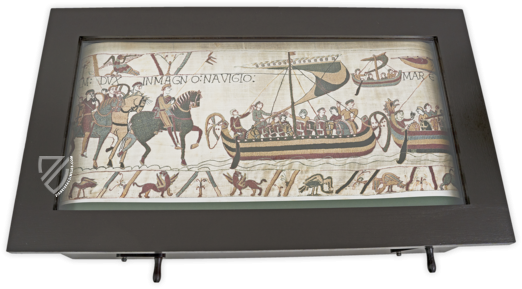Secretum Templi II
(3,000€ - 7,000€)
Founded in 1118 by a group of nine knights protecting pilgrims in the Holy Land, the Knights Templar or Poor Fellow-Soldiers of Christ and of the Temple of Solomon grew in to one of the wealthiest, most powerful, and famous monastic military orders of the Middle Ages. At the height of their power, they had nearly 20,000 members and controlled hundreds of castles and other properties. However, their downfall was just as spectacular when they became victims to a plot by the heavily indebted King Philip IV of France the Fair (1268-1314) at the beginning of the 14th century, whereupon the Templars were put on trial for heresy and other trumped-up crimes in 1307. In addition to the famous Chinon Parchment of 1308, the Secretum Templi II document collection features various records of interrogations and other documents relating to the trials of the Templars on the Iberian Peninsula as well as the written absolution of the Knights Templar in Spain dating from 1312.
Secretum Templi II
This compendium of documents consists of records from the interrogations of the Templars that occurred after the Order was accused of heresy and various other crimes. Most of these are records of the interrogations at Chinon (August 17–20, 1308), Lleida (February 15-March 17, 1310), Medina del Campo (April 1310), and Valladolid (May 1310). Other documents include a letter from the Papal envoy in Lleida dated the 6th of March 1311, Berardo de Poggio Bustone, to the bishops of the Kingdom of Aragon concerning the preparation of the investigations against the Templars and a sentence of absolution given to the Spanish Templars by the Council of Tarragona (November 4–7, 1312), which nonetheless disbanded the Order, allowing some of the members to join other orders or assigning them life pensions.
The Crusades’ Greatest Warriors
Founded in 1119 and headquartered at the Temple Mount in Jerusalem, the Poor Fellow-Soldiers of Christ and of the Temple of Solomon, more commonly known as the Knights Templar, emerged out of a need to protect pilgrims from bandits and anyone else who would harm them. It grew from an impoverished order of only 9 knights into the richest, most powerful monastic military order of the Middle Ages with a network of 1,000 commanderies and fortifications stretching from the Holy Land to Scotland. They also helped to develop many banking techniques like checks and letters of credit and are considered to be the world’s first multi-national corporation.
In fact, only 10% of the Templars were actually knights, the rest of the order, numbering as much as 20,000 at its peak, were in charge of the banking, bureaucracy, and logistics supporting their military operations. Nonetheless, those brothers who trained for war did so with religious fervor and fought without fear of death and as such, the presence of even a small number of Templars on a battlefield could be enough to change the outcome of an engagement. They were simply some of the most capable warriors in the entire Crusades.
Downfall of the Templars
As the Crusaders were gradually pushed out of the Holy Land, the Templars found themselves without a mission and became the victims of a conspiracy by King Philip IV of France. Heavily indebted to the Order, Philip levelled accusations of heresy at the Templars and on Friday October 13th, 1307 had many of the order’s top members arrested. They were subsequently tortured into giving false confessions and burned at the stake – while also having their assets seized by the French Crown of course. Pope Clement V, a French pontiff who was the first Avignon pope and arguably a puppet of the French King, disbanded the order in 1312, with most of the Templars assets and membership going over to the Hospitallers and other orders.
As he burned at the stake and prayed, Grand Master Jacques de Molay predicted that he would soon meet both Clement and Philip before God saying “God knows who is wrong and has sinned. Soon a calamity will occur to those who have condemned us to death”. Clement was dead within a month, Philip was dead eight months later, and his male line was extinguished by 1328. The whole affair scandalized people’s sense of justice and it was whispered across Europe that this had been divine punishment for sins of the King and the Pope.
Codicology
- Alternative Titles
- Secretum Templi II "Proceso contra los Templarios en España"
- Size / Format
- Diverse documents / 21.0-67.0 × 21.0-62.1 cm
- Origin
- Spain
- Date
- 1308–1312
- Epochs
- Style
- Language
- Illustrations
- 1 decorated initial and several symbols
- Content
- „Chinon Parchment" (1308), "Interrogation of the Templars" (Castile and Leon, 1310), "Interrogation of the Templars" (Catalonia, Kingdom of Aragon and Navarre, 1310) and the "Absolution of the Templars in Spain" (Kingdom of Aragon, 1312)
Secretum Templi II
The Absolution of the Spanish Templars
After the arrest of the Templars in France, King James II of Aragon also ordered the imprisonment of the brethren. He took the opportunity to seize all the castles of the order by 1309. The trial against the Spanish Knights Templar began the following year, but failed to prove the numerous accusations of heresy. During a final provincial council in Tarragona in 1312, eight Templars were questioned again under torture without confessing, whereupon the accused were absolved.
The final document of this council, which contains the absolution of the Spanish Knights Templar, has survived to this day. As usual, the document begins with a list of the involved parties, including the Bishop of Tarragona and the Bishop of Valencia as well as several suffragan bishops. This is followed by an explanation of the accusations from which the brethren are acquitted on leaf 4r, which is shown here.
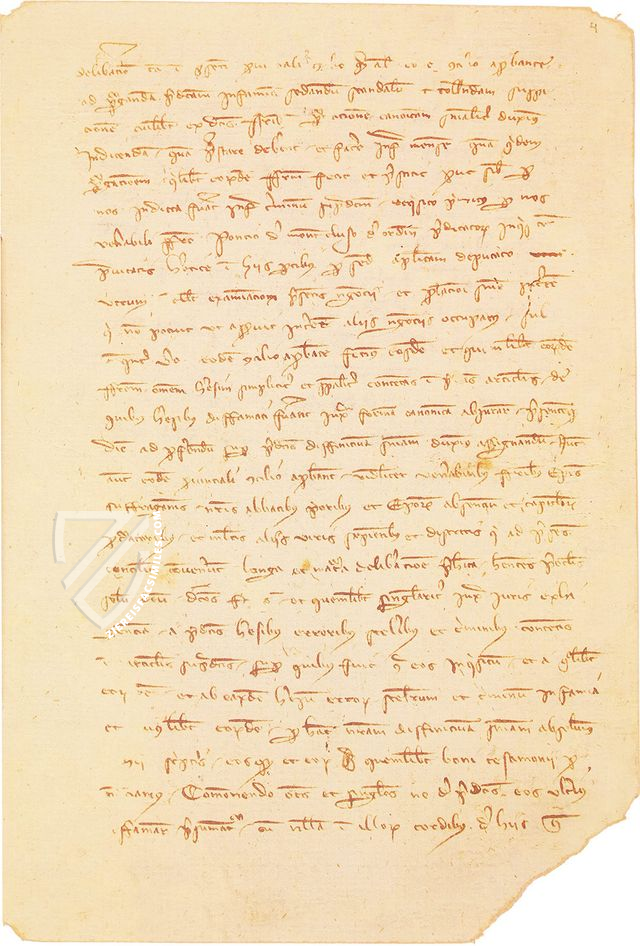
#1 Secretum Templi II "Proceso contra los Templarios en España"
Language: Spanish
(3,000€ - 7,000€)
- Treatises / Secular Books
- Apocalypses / Beatus
- Astronomy / Astrology
- Bestiaries
- Bibles / Gospels
- Chronicles / History / Law
- Geography / Maps
- Saints' Lives
- Islam / Oriental
- Judaism / Hebrew
- Single Leaf Collections
- Leonardo da Vinci
- Literature / Poetry
- Liturgical Manuscripts
- Medicine / Botany / Alchemy
- Music
- Mythology / Prophecies
- Psalters
- Other Religious Books
- Games / Hunting
- Private Devotion Books
- Other Genres
- Afghanistan
- Armenia
- Austria
- Belgium
- Belize
- Bosnia and Herzegovina
- China
- Colombia
- Costa Rica
- Croatia
- Cyprus
- Czech Republic
- Denmark
- Egypt
- El Salvador
- Ethiopia
- France
- Germany
- Greece
- Guatemala
- Honduras
- Hungary
- India
- Iran
- Iraq
- Israel
- Italy
- Japan
- Jordan
- Kazakhstan
- Kyrgyzstan
- Lebanon
- Liechtenstein
- Luxembourg
- Mexico
- Morocco
- Netherlands
- Palestine
- Panama
- Peru
- Poland
- Portugal
- Romania
- Russia
- Serbia
- Spain
- Sri Lanka
- Sweden
- Switzerland
- Syria
- Tajikistan
- Turkey
- Turkmenistan
- Ukraine
- United Kingdom
- United States
- Uzbekistan
- Vatican City
- A. Oosthoek, van Holkema & Warendorf
- Aboca Museum
- Ajuntament de Valencia
- Akademie Verlag
- Akademische Druck- u. Verlagsanstalt (ADEVA)
- Aldo Ausilio Editore - Bottega d’Erasmo
- Alecto Historical Editions
- Alkuin Verlag
- Almqvist & Wiksell
- Amilcare Pizzi
- Andreas & Andreas Verlagsbuchhandlung
- Archa 90
- Archiv Verlag
- Archivi Edizioni
- Arnold Verlag
- ARS
- Ars Magna
- ArtCodex
- AyN Ediciones
- Azimuth Editions
- Badenia Verlag
- Bärenreiter-Verlag
- Belser Verlag
- Belser Verlag / WK Wertkontor
- Benziger Verlag
- Bernardinum Wydawnictwo
- BiblioGemma
- Biblioteca Apostolica Vaticana (Vaticanstadt, Vaticanstadt)
- Bibliotheca Palatina Faksimile Verlag
- Bibliotheca Rara
- Boydell & Brewer
- Bramante Edizioni
- Bredius Genootschap
- Brepols Publishers
- British Library
- C. Weckesser
- Caixa Catalunya
- Canesi
- CAPSA, Ars Scriptoria
- Caratzas Brothers, Publishers
- Carus Verlag
- Casamassima Libri
- Centrum Cartographie Verlag GmbH
- Chavane Verlag
- Christian Brandstätter Verlag
- Circulo Cientifico
- Club Bibliófilo Versol
- Club du Livre
- CM Editores
- Collegium Graphicum
- Collezione Apocrifa Da Vinci
- Comissão Nacional para as Comemorações dos Descobrimentos Portugueses
- Coron Verlag
- Corvina
- CTHS
- D. S. Brewer
- Damon
- De Agostini/UTET
- De Nederlandsche Boekhandel
- De Schutter
- Deuschle & Stemmle
- Deutscher Verlag für Kunstwissenschaft
- DIAMM
- Droz
- E. Schreiber Graphische Kunstanstalten
- Ediciones Boreal
- Ediciones Grial
- Ediclube
- Edições Inapa
- Edilan
- Editalia
- Edition Deuschle
- Edition Georg Popp
- Edition Leipzig
- Edition Libri Illustri
- Editiones Reales Sitios S. L.
- Éditions de l'Oiseau Lyre
- Editions Medicina Rara
- Editorial Casariego
- Editorial Mintzoa
- Editrice Antenore
- Editrice Velar
- Edizioni Edison
- Egeria, S.L.
- Eikon Editores
- Electa
- Emery Walker Limited
- Enciclopèdia Catalana
- Eos-Verlag
- Ephesus Publishing
- Ernst Battenberg
- Eugrammia Press
- Extraordinary Editions
- Fackelverlag
- Facsimila Art & Edition
- Facsimile Editions Ltd.
- Facsimilia Art & Edition Ebert KG
- Faksimile Verlag
- Feuermann Verlag
- Folger Shakespeare Library
- Franco Cosimo Panini Editore
- Friedrich Wittig Verlag
- Fundación Hullera Vasco-Leonesa
- G. Braziller
- Gabriele Mazzotta Editore
- Gebr. Mann Verlag
- Gesellschaft für graphische Industrie
- Getty Research Institute
- Giovanni Domenico de Rossi
- Giunti Editore
- Graffiti
- Grafica European Center of Fine Arts
- Guido Pressler
- Guillermo Blazquez
- Gustav Kiepenheuer
- H. N. Abrams
- Harrassowitz
- Harvard University Press
- Helikon
- Hendrickson Publishers
- Henning Oppermann
- Herder Verlag
- Hes & De Graaf Publishers
- Hoepli
- Holbein-Verlag
- Houghton Library
- Hugo Schmidt Verlag
- Idion Verlag
- Il Bulino, edizioni d'arte
- ILte
- Imago
- Insel Verlag
- Insel-Verlag Anton Kippenberger
- Instituto de Estudios Altoaragoneses
- Instituto Nacional de Antropología e Historia
- Introligatornia Budnik Jerzy
- Istituto dell'Enciclopedia Italiana - Treccani
- Istituto Ellenico di Studi Bizantini e Postbizantini
- Istituto Geografico De Agostini
- Istituto Poligrafico e Zecca dello Stato
- Italarte Art Establishments
- Jan Thorbecke Verlag
- Johnson Reprint Corporation
- Josef Stocker
- Josef Stocker-Schmid
- Jugoslavija
- Karl W. Hiersemann
- Kasper Straube
- Kaydeda Ediciones
- Kindler Verlag / Coron Verlag
- Kodansha International Ltd.
- Konrad Kölbl Verlag
- Kurt Wolff Verlag
- La Liberia dello Stato
- La Linea Editrice
- La Meta Editore
- Lambert Schneider
- Landeskreditbank Baden-Württemberg
- Leo S. Olschki
- Les Incunables
- Liber Artis
- Library of Congress
- Libreria Musicale Italiana
- Lichtdruck
- Lito Immagine Editore
- Lumen Artis
- Lund Humphries
- M. Moleiro Editor
- Maison des Sciences de l'homme et de la société de Poitiers
- Manuscriptum
- Martinus Nijhoff
- Maruzen-Yushodo Co. Ltd.
- MASA
- Massada Publishers
- McGraw-Hill
- Metropolitan Museum of Art
- Militos
- Millennium Liber
- Müller & Schindler
- Nahar - Stavit
- Nahar and Steimatzky
- National Library of Wales
- Neri Pozza
- Nova Charta
- Oceanum Verlag
- Odeon
- Orbis Mediaevalis
- Orbis Pictus
- Österreichische Staatsdruckerei
- Oxford University Press
- Pageant Books
- Parzellers Buchverlag
- Patrimonio Ediciones
- Pattloch Verlag
- PIAF
- Pieper Verlag
- Plon-Nourrit et cie
- Poligrafiche Bolis
- Presses Universitaires de Strasbourg
- Prestel Verlag
- Princeton University Press
- Prisma Verlag
- Priuli & Verlucca, editori
- Pro Sport Verlag
- Propyläen Verlag
- Pytheas Books
- Quaternio Verlag Luzern
- Reales Sitios
- Recht-Verlag
- Reichert Verlag
- Reichsdruckerei
- Reprint Verlag
- Riehn & Reusch
- Roberto Vattori Editore
- Rosenkilde and Bagger
- Roxburghe Club
- Salerno Editrice
- Saltellus Press
- Sandoz
- Sarajevo Svjetlost
- Schöck ArtPrint Kft.
- Schulsinger Brothers
- Scolar Press
- Scrinium
- Scripta Maneant
- Scriptorium
- Shazar
- Siloé, arte y bibliofilia
- SISMEL - Edizioni del Galluzzo
- Sociedad Mexicana de Antropología
- Société des Bibliophiles & Iconophiles de Belgique
- Soncin Publishing
- Sorli Ediciones
- Stainer and Bell
- Studer
- Styria Verlag
- Sumptibus Pragopress
- Szegedi Tudomànyegyetem
- Taberna Libraria
- Tarshish Books
- Taschen
- Tempus Libri
- Testimonio Compañía Editorial
- Thames and Hudson
- The Clear Vue Publishing Partnership Limited
- The Facsimile Codex
- The Folio Society
- The Marquess of Normanby
- The Richard III and Yorkist History Trust
- Tip.Le.Co
- TouchArt
- TREC Publishing House
- TRI Publishing Co.
- Trident Editore
- Tuliba Collection
- Typis Regiae Officinae Polygraphicae
- Union Verlag Berlin
- Universidad de Granada
- University of California Press
- University of Chicago Press
- Urs Graf
- Vallecchi
- Van Wijnen
- VCH, Acta Humaniora
- VDI Verlag
- VEB Deutscher Verlag für Musik
- Verlag Anton Pustet / Andreas Verlag
- Verlag Bibliophile Drucke Josef Stocker
- Verlag der Münchner Drucke
- Verlag für Regionalgeschichte
- Verlag Styria
- Vicent Garcia Editores
- W. Turnowski Ltd.
- W. Turnowsky
- Waanders Printers
- Wiener Mechitharisten-Congregation (Wien, Österreich)
- Wissenschaftliche Buchgesellschaft
- Wissenschaftliche Verlagsgesellschaft
- Wydawnictwo Dolnoslaskie
- Xuntanza Editorial
- Zakład Narodowy
- Zollikofer AG

